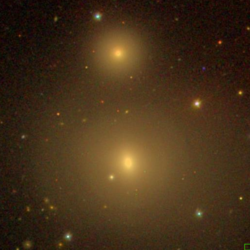Astronomy:NGC 507
From HandWiki
Short description: Galaxy in the constellation Pisces
| NGC 507 | |
|---|---|
 | |
| Observation data (J2000 epoch) | |
| Constellation | Pisces |
| Right ascension | 01h 23.7m 00s[1] |
| Declination | +33° 15′ 00″[1] |
| Redshift | 0.0165[2] |
| Helio radial velocity | 4934 +/- 7 km/s[3] |
| Galactocentric velocity | 5079 +/- 9 km/s[3] |
| Distance | 227 million light years away[2] |
| Apparent magnitude (V) | 11.3[1] |
| Apparent magnitude (B) | 12.3[1] |
| Surface brightness (specify) | 13.5[2] |
| Characteristics | |
| Type | SA00(r)[3] |
| Apparent size (V) | 2.5' x 2.5'[2] |
| Other designations | |
| Arp 229, CGCG 502-67, MCG 5-4-44, PGC 5098, UGC 938, V V 207 | |
NGC 507, also known as Arp 229, CGCG 502-67, MCG 5-4-44, PGC 5098, UGC 938, and V V 207,[2] is a lenticular galaxy in the constellation Pisces. It was described as being "very faint", "pretty large", "round", "brighter in the middle", and "south of NGC 508" by John Dreyer in the New General Catalogue.[1] The two galaxies (NGC 507 and NGC 508) are a part of the Atlas of Peculiar Galaxies, where NGC 507 is described as "Circular or near circular rings of small density difference."[4]
It was discovered by William Herschel on September 12, 1784.[5]
See also
References
- ↑ Jump up to: 1.0 1.1 1.2 1.3 1.4 Frommert, Hartmut. "NGC 507". http://spider.seds.org/ngc/ngc.cgi?507.
- ↑ Jump up to: 2.0 2.1 2.2 2.3 2.4 García Rojas, Sebastián. "Galaxy NGC 507 · Telescopius". https://telescopius.com/deep-sky/object/1397/ngc-507/galaxy.
- ↑ Jump up to: 3.0 3.1 3.2 "Your NED Search Results". https://ned.ipac.caltech.edu/cgi-bin/objsearch?objname=NGC+507&extend=no&hconst=73&omegam=0.27&omegav=0.73&corr_z=1&out_csys=Equatorial&out_equinox=J2000.0&obj_sort=RA+or+Longitude&of=pre_text&zv_breaker=30000.0&list_limit=5&img_stamp=YES.
- ↑ Arp, Halton (November 1966). "Atlas of Peculiar Galaxies". Astrophysical Journal Supplement 14: 1. doi:10.1086/190147. Bibcode: 1966ApJS...14....1A.
- ↑ "New General Catalog Objects: NGC 500 - 549". http://cseligman.com/text/atlas/ngc5.htm#507.
External links
- NGC 507 on WikiSky: DSS2, SDSS, GALEX, IRAS, Hydrogen α, X-Ray, Astrophoto, Sky Map, Articles and images
- SEDS
Coordinates: ![]() 01h 23.7m 00s, +33° 15′ 00″
01h 23.7m 00s, +33° 15′ 00″
 |


